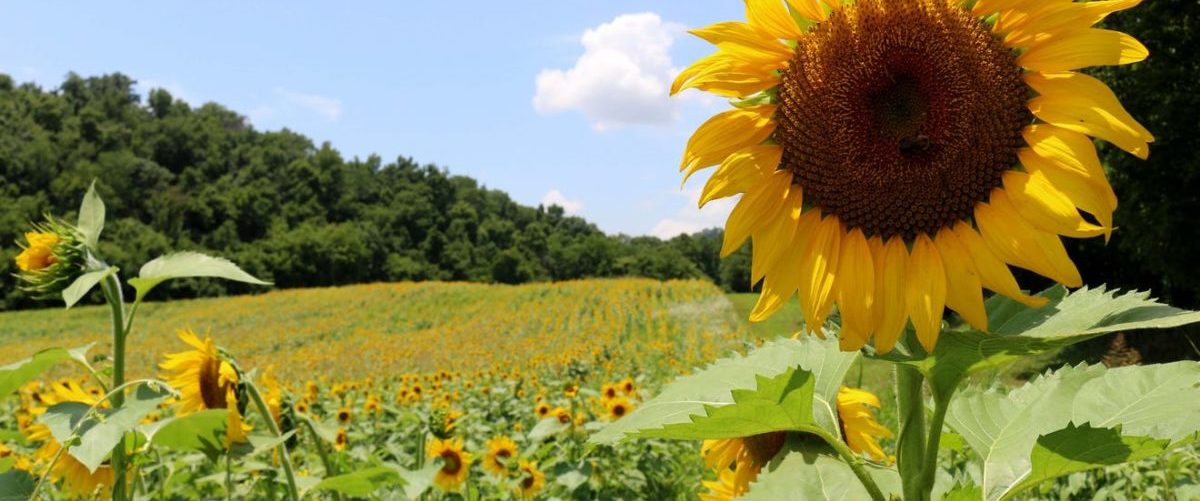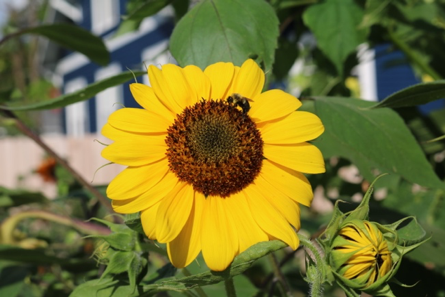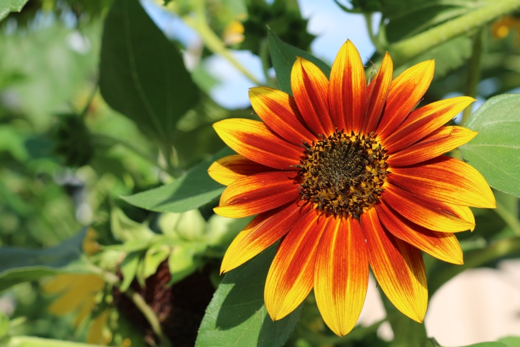November: Helianthus annuus– The Common Sunflower
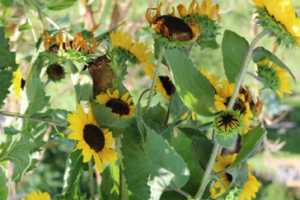
Sunflowers. Photo by Ileana Ilas, 2020.
The common sunflower (Helianthus annuus) is a fitting plant of the month for November, which is Native American Heritage Month. Native peoples living in the eastern US domesticated sunflowers – selecting for larger seeds – by at least 4,000 years ago!
The general Sunflower or Helianthus genus is easily identifiable based on the following plant characteristics:
- It has showy, vibrant flower petals (primarily shades of yellow) known as ray flowers that surround the brown central disk flowers.
- There is usually a central head of flowers with some offshoots.
- It has visible hairs along the main stem.
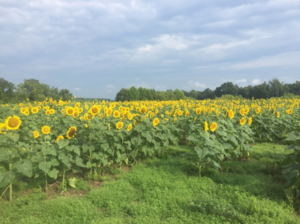
Sunflower field. Photo by Peggy Humes, 2020.
Sunflower is an annual plant, meaning it flowers and produces seeds each year and then dies back at the end of the growing season. Sunflowers are noted for their heliotropism, where the plant’s flower head tracks the movement of the sun across the sky each day as it grows. Sunflowers are classified in the Aster Family (Asteraceae), currently the largest plant family with approximately 23,600 identified species.
Native Americans living in the Midsouth domesticated sunflowers around 4,000 years ago, selecting those that produced larger seeds. The oldest domesticated seed actually comes from the Hayes site (40ML139) in Middle Tennessee, with a date of 4,200 years old (Crites, 1993)! Native Americans continued to grow them for their tasty seeds, often planting them along the edges of their “Three Sisters” gardens, with beans growing up the sunflower stems as well as corn stalks. They ground the seeds into flour and for cooking oil, and used the plants in medicinal remedies. Sunflower heads are also a tasty treat when oiled and roasted on an outside grill. See this posting from Baker Creek Heirloom Seed Company for more information and recipes.
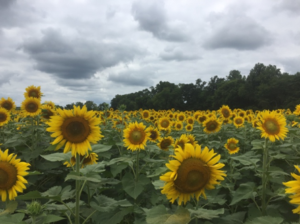
Sunflowers in a field. Photo by Peggy Humes, 2020
Historically, sunflower varieties contributed to well-being beyond the plate. Leesa Jones, curator of the Washington Waterfront Underground Railroad Museum, establishes the use of plants as signals along the Underground Railroad. Sunflowers and similar plants in the Aster Family were used as messages along the Underground Railroad to inform enslaved people of a clear passage or a warning of caution if an area was not safe to pass through. For example, the large sunflower’s face/head of blooms meant more eyes watching, but was replaced with the smaller Black-eyed Susan (Rudbeckia sp.) to indicate fewer eyes were watching in the area. These flowers were usually set out for display, not for sale or trade, but near open markets and visibly on porches for display indicating safehouses or forms of safety.
Sources and Additional Reading:
Crites, Gary.1993 “Domesticated Sunflower in Fifth Millennium B.P. Temporal Context: New Evidence from Middle Tennessee.” American Antiquity. 58(1). Cambridge University Press.
Edge, John T. (Ed.) 2007 The New Encyclopedia of Southern Culture: Volume 7: Foodways. University of North Carolina Press. Chapel Hill, North Carolina.
Elpel, Thomas J. 2018 Botany in a Day: The Patterns Method of Plant Identification 6th ed. HOPS Press, LLC. Pony, Montana.
Fernald, Merritt and Alfred Kinsey. 1943 Edible Wild Plants of Eastern North America. Harper & Row Publishers Inc. New York City, New York.
Kara Holsopple. “How Plants were Used to Gain Freedom on the Underground Railroad” The Allegheny Front, September 15, 2017.
Yarnell, R.A. 1978 Domestication of Sunflower and Sumpweed in Eastern North America. In The Nature and Status of Ethnobotany, edited by R. I. Ford, pp. 289-299. Anthropological Papers No. 67. Museum of Anthropology, University of Michigan, Ann Arbor.
“Edible Flowers Chart” What’s Cooking America
